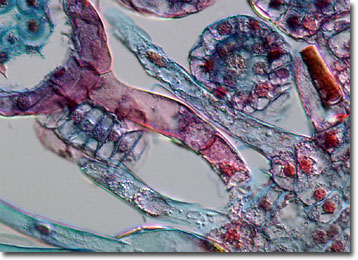Differential Interference Contrast Image Gallery
Fern (Polypodium) Leaves
Polypodium is a genus of the primitive vascular plants commonly known as ferns. Most often found in the New World, Polypodium species are generally epiphytes, plants that grow above ground but are supported in a non-parasitic manner by other flora or objects.

More than 10,000 species of fern have been scientifically catalogued, some of which date back 360 million years ago to the Carboniferous period. Man has utilized the plants in various ways since he first began to walk on the Earth. Ferns, or parts of the ferns, have been used as a food source, as bedding and stuffing for cushions, as medicinal treatments, as material for roof thatching, and as ornamentals. Most recently, ferns have acted as a subject of study in biological research, scientists being extremely interested in their retainment of a primitive lifecycle that involves two separate, generally independent generations.
The first generation of ferns is grown asexually from spores. On the underside of fertile fronds spore cases, or sporangia, are stored. When the spores are ripe, the cases burst and the spores are scattered. If they land in a suitable environment, each spore develops into a small, flat green organism rooted in the ground, which is known as a prothallium. The prothallium bears specialized reproductive structures on its underside, one of which holds eggs, and the other of which contains sperm. This design enables the prothallium to sexually reproduce by fertilizing its own eggs. Each egg fertilized in this manner is capable of growing into a young fern that grows fronds and produces spores.
